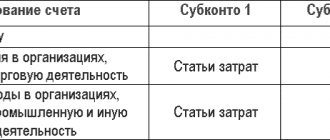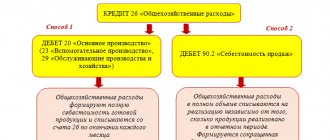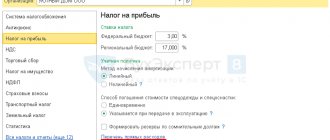Any business involves certain types of costs. Among them, a significant place is occupied by the so-called commercial expenses. The efficiency of the entire economic and production system of the enterprise depends on their formation and management.
Let's consider what an organization's commercial expenses are, what influences their distribution and analysis, how to correctly reflect them in financial accounting, and also give specific examples of calculations regarding commercial expenses.
sales expenses (commercial expenses) in the accounting of a production organization if the accounting policy for accounting purposes provides for the complete write-off of such expenses to the cost of sales?
Let's decipher the term business expenses
If an organization is engaged in the production and sale of goods and/or services, it will certainly incur costs directly related to its direct activities. Costs directly for production are taken into account separately, the rest are called commercial, otherwise non-productive.
What expenses are included in business expenses ?
These types of expenses include:
- costs associated with the shipment of goods sold;
- expenses associated with the implementation process;
- the cost of packaging or containers, if it is not produced but purchased from another organization;
- payment to third-party packers if their services are used;
- costs of delivering goods to the destination specified in the contract;
- advertising and marketing expenses;
- commissions and deductions to intermediaries;
- rental of warehouses, shops, etc.;
- ensuring storage of goods;
- representation expenses;
- licensing and/or certification costs;
- wages for distributors;
- other expenses close to their intended purpose.
NOTE! It is allowed to include in business expenses costs not only for sales, but also for the purchase of goods. Such costs are called transport and procurement costs (TPP). They are distributed between goods already sold and goods not yet sold.
How are selling expenses (line 2210) reflected in the income statement
Selling expenses of trading and manufacturing companies, which were reflected on account 90, are subject to accounting in the total cost of sales. Such costs should be reflected in line 2210 “Business expenses” in the income statement.
It also happens that an enterprise does not use account 44. This is only possible if the costs collected on the account do not have a component that is subject to mandatory distribution. If the company does not use an account. 44, business expenses are usually reflected in account 26, which is closed in 2 ways:
- By writing off the total amount of expenses accumulated by the company on account 26, directly to the debit of account 90 (then commercial expenses fall into line 2220 “Administrative expenses”).
- By including in the cost of finished goods the method of distributing the expenses collected by the company on account 26 (then the expenses are included in the amount of line 2120 “Cost of sales” in the process of writing off the cost of goods sold).
The role of commercial expenses in the economic mechanism of the organization
Only those business activities that effectively record and manage their financial results, which include business expenses, will be successful. The factors of their influence on the economic mechanism are very significant and diverse.
- A direct connection with the profitability of production - an analysis of the dynamics of business expenses and ways to manage them shows ways to increase the efficiency of business, as well as “weaknesses” that should be given increased attention.
- Determination of reserves for reducing production costs . The rise or fall of business costs clearly shows the financial potential for different types of activities and types of goods produced.
- Pricing policy – accounting for business expenses allows you to correctly set prices for the company’s products.
- Calculation of economic efficiency in case of technology changes, modernization, acquisition of new equipment, etc.
- Formation of a product range - justification for making decisions on the removal of any products from production or the introduction of new ones.
- Dominant position in the financial accounting of the organization - it is commercial indicators that are the main accounting reporting units.
- Impact on national income throughout the state.
What accounting data is used when filling out line 2210 “Business expenses” ?
How are business expenses calculated?
One of the key commercial characteristics of a product is its cost. It can only be determined during the production process, since it consists of the amount of funds spent on the production itself (production costs) and on sales (commercial costs).
The organization's accounting must take into account such costs in account 43 “Business expenses”. The debit shows the costs of selling products for the reporting month, the credit shows the amounts that were written off for products sold in the reporting month, and the balance shows the costs of shipped products that have not yet been paid for at the beginning dates of the month.
The debit of account 43 “Business expenses” allows you to take into account this type of cost, which passes through the credits of the following accounts:
- costs for containers and packaging – account 10 “Materials”;
- expenses for transport delivery of sold products to the buyer’s warehouse or to the point of further departure (airport, port, railway station) - account 23 “Auxiliary means”;
- payment for delivery to the buyer, if it is carried out by a third party - account 60 “Settlements with suppliers and contractors”;
- salaries for employees accompanying products, sellers, etc. – account 70 “settlements with personnel for wages”.
Statement 15 for accounting for general business expenses, future and non-production, reflects the result of analytical accounting of business expenses.
When the accounting month ends, these types of expenses are written off to cost of goods sold. You can use a direct route for this (for specific types of products), and it is permissible to distribute costs in proportion to the cost and number of goods sold (if it is difficult to classify products into one group or another). To do this, the following accounting entry is used:
- debit 46 “Sales of products, works, services”;
- credit 43 “Business expenses”.
FOR YOUR INFORMATION! If during the reporting month not all of the planned products were sold, but only some part of them, then it is advisable to distribute commercial expenses for the sold and unsold part of the products, for example, according to the cost of goods or in another acceptable way.
New chart of accounts and business expenses
One of the accounting innovations provides for the posting of commercial expenses in account 44 “Sales expenses”. The debit of this account accumulates the amounts of funds spent on the sale of goods, services, and work performed. The assets in this account are written off as a debit to account 90 “Sales”.
Selling expenses on the balance sheet
The balance sheet does not provide a special item for business expenses. When drawing up a balance, the balance of funds in account 43 “Business expenses” is added to the balances accumulated in account 45 “Shipped goods”.
Reflection of selling expenses in financial statements
Profit or loss from sales (line 2200) is calculated as revenue (line 2110), reduced by cost of sales (line 2120), CR (line 2210) and administrative expenses (line 2220).
According to PBU 10/99 KR, these are expenses for ordinary activities, that is, directly related to production and sales. Page 2210 of Form 2 is formed as a debit turnover of account 90 “Sales” (sub-account “Cost of sales”) in correspondence with account 44 “Sales expenses”.
For an example of calculating and reflecting KR in Form 2, see ConsultantPlus. Trial access to the system can be obtained for free.
Business expenses and taxation
The difficulty is that it is necessary to separate the costs of selling products and advertising costs, which are also non-sales, but are standardized according to another article of the Tax Code (clause 4 of Article 264 of the Tax Code of the Russian Federation).
In the income tax, the share of advertising tax will be no more than 1% of revenue, which will make the difference in tax and accounting.
FOR EXAMPLE. For the reporting period, Primavera LLC received incremental revenue in the amount of RUB 6,500,000. excluding value added tax. Advertising expenses according to accounting data amounted to 70,000 rubles. Let's calculate how much advertising costs can be used to calculate income tax.
According to the rate of advertising costs given in paragraph 4 of Art. 264 of the Tax Code of the Russian Federation, advertising expenses cannot exceed 1% of revenue: 6,500,000 x 1% = 65,000 rubles. This percentage is less than the funds actually spent on advertising - 70,000 rubles. Consequently, income tax will be calculated only on 65,000 rubles, and the difference in tax and accounting will be 5 thousand rubles.
What settings determine the result of cost calculation?
Cost is the monetary expression of the costs of production and sale of products, which consists of costs associated with the use of fixed assets, raw materials, materials, fuel and energy, labor, as well as other costs for its production and sale in the production process of industrial products (clause clauses 3, 8 “Basic provisions for cost calculation”).
The result of cost calculation (the actual cost of products in accounting and tax accounting) in “1C: Accounting 8” is reflected in the calculation certificates Cost of manufactured products and services and Cost calculation (Fig. 4), which are also available from the assistant form Closing the month
(section Operations).
Rice. 4. Costing
What does this result depend on? First of all, of course, it depends on the composition of direct costs and the order of distribution of indirect ones. But not only. Direct costs in the program include:
- directly to a specific product name;
- by type of product (per product group) with subsequent distribution by product name.
To understand how this happens, let's look at the cost account of the main production. In addition to cost items (which we wrote about above), analytical accounting for account 20.01 is carried out by types of products (works, services) (subconto Nomenclature groups) and by names of products (works, services) (subconto Products).
Each item group is an element of the Nomenclature Groups directory (section Directories), and each product name is an element of the Nomenclature directory (section Directories).
The Nomenclature Groups directory stores information about goods, products, works, and services in homogeneous groups, for which aggregated accounting of sales revenue and production costs is maintained.
The use of nomenclature groups is based on the assumption that many names of goods, products, works and services can be combined into groups with a homogeneous material composition.
Nomenclature is a directory for storing information about inventory items (including finished products), work performed, and services provided.
To get an accurate cost calculation, you need to fill in the Products field in production cost accounting documents (for example, Production Report for a Shift, Receipt from Processing, Request Invoice, etc.).
The Products field can be left blank for those costs for which it is either unknown or impractical to determine what specific product they were spent on. In this case, direct costs are distributed across the product group in a certain way.
| 1C: Accounting 8: setting up accurate cost calculations taking into account the use of specific materials |
How will direct costs be distributed within the item group? This depends on the accounting policy settings in the settings block for calculating the cost of production (see Fig. 3).
If the Use planned production cost flag is checked, then planned prices must be indicated in documents for the release of finished products and the provision of production services. Direct costs not allocated to specific products will be distributed within the product group in proportion to the planned cost.
If the Use planned production cost flag is not set, then planned prices are not required to be indicated in production documents. Costs that are direct in relation to the product group will be distributed in proportion to the costs that are direct in relation to specific products.
In any case, the actual cost is determined at the end of the month when performing a routine operation to close cost accounts.
| 1C: Accounting 8: how to distribute direct production costs without using planned cost |
Optimization of business expenses
Effectively reducing sales costs is a direct path to increased profitability and profitability. The following ways to optimize this type of expense can be identified:
- cost reduction should not be an end in itself; it is much more important to organize effective management;
- any unit of spending should bring the most effective result;
- it should be remembered that expenses are the result of both actions and inactions;
- cost reduction is impossible without corresponding costs invested in it;
- maintaining the level of spending at an optimal level is already considered successful from the point of view of economic efficiency;
- one should not skimp on expenses that will help insure against more significant costs;
- Analytical work to optimize commercial costs must be ongoing.







